How to Grow an Orange Tree in Container | Orange Tree in Pot
Growing oranges in pots allow you to enjoy its fruits even if you have limited space! Learn How to Grow an Orange Tree in Container with ease!
Oranges are praised for their tangy and sweet taste. Growing them in pots offers you a chance to grow them in small spaces, like balconies and patios, in cold climates. You can also move the containers indoors in winters or when the weather is not favorable. The fruity fragrance of the flowers is also an added advantage while growing them! Let’s have a look at How to Grow an Orange Tree in Container!
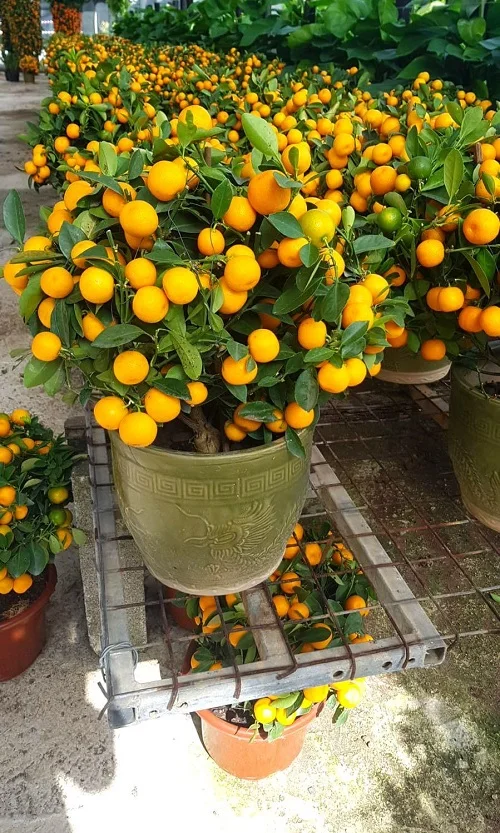
Botanical Name: Citrus sinensis
USDA Zones: 9-11
Soil pH: 6.0-7.5
How to Propagate Orange Tree in Container
There are mainly two ways in which you can grow oranges. Though growing an Orange tree in a container from seeds or cuttings is possible, we recommend you buy a healthy, well-grafted plant from a nursery. Pick a variety that suits your climate.

1. From Cuttings
- Take 6-10 inches of softwood cuttings from the first-year branch of a healthy tree. Make sure you are not cutting a stem with fruits or flowers.
- Remove the leaves from the bottom part of the cutting and dip its end in a rooting hormone.
- Fill potting mix in a pot and plant the cutting 2-3 inches deep and press soil firmly around it.
- Keep it in dappled sunlight and water it regularly, allowing the topsoil to dry between the watering intervals.
- In 8-12 weeks, the roots will start emerging. Transplant it to 12-15 inches pot and keep it under full sun.
2. From Seeds

- For propagating an orange tree from the seeds, extract the seeds out of the fruit and soak them for 24 hours in water.
- Sow the seeds half an inch deep in a 4-6 inches pot filled with potting mix. Water it thoroughly after sowing.
- The seeds will germinate in 3-4 weeks.
- Transfer it in a bigger pot (10-12 inches), when the plant outgrows the old one, and place it in full sun exposure.
Best Orange Tree Varieties for Pots
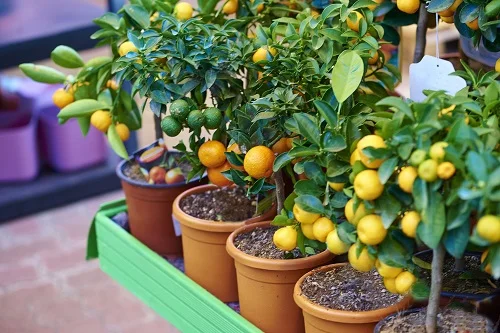
1. Navel Orange: This is one of the most popular types of orange trees for growing in pots. Its fruit is sweet and seedless, making it perfect for juicing.
2. Dwarf Washington Navel: This variety is a great choice for small spaces, as it only grows to about 8 feet tall. It produces sweet, juicy oranges that are ideal for juicing and eating.
3. Golden Nugget: This is a sweet, tasty orange with a deep yellow color. It’s ideal for growing in pots, as it only grows to around 6 feet tall.
4. Valencia: This is a large, juicy orange that is perfect for juicing. It’s great for growing in pots, as it only gets to around 10 feet tall.
5. Satsuma: This variety is known for its easy-to-peel skin and sweet flavor. It’s a less acidic orange, making it perfect for juicing. It grows to around 8 feet tall, making it great for growing in pots.
6. Trovita: This variety is slightly smaller than Washington’s and produces sour and sweet fruits with few seeds. They are not cold and hardy but can withstand short periods of freezing temperatures.
7. Mandarin: It has sweet fruits, which can either be eaten plain or used in salads. This variety can be damaged by cold, so bring it inside during winter.
8. Blood Moro: It produces sweet, deep red blood oranges with a hint of raspberry in taste.
Here are some popular Orange varieties from India
9. Nagpur: It is a large-sized variety with a deep orange color. It has a sweet, juicy, and tangy flavor. The skin is thin, and the pulp is firm and juicy.
10. Navel: The Navel orange is a large-sized variety with thick orange skin. It has a sweet and juicy flavor with a slight tang. Its pulp is orange-colored with a creamy texture.
11. Kalinga: Kalinga oranges are small-sized varieties with thin orange skin. They have a sweet and tangy flavor with a juicy texture. The pulp is orange-colored with a thick texture.
Choosing a Container for Growing Orange
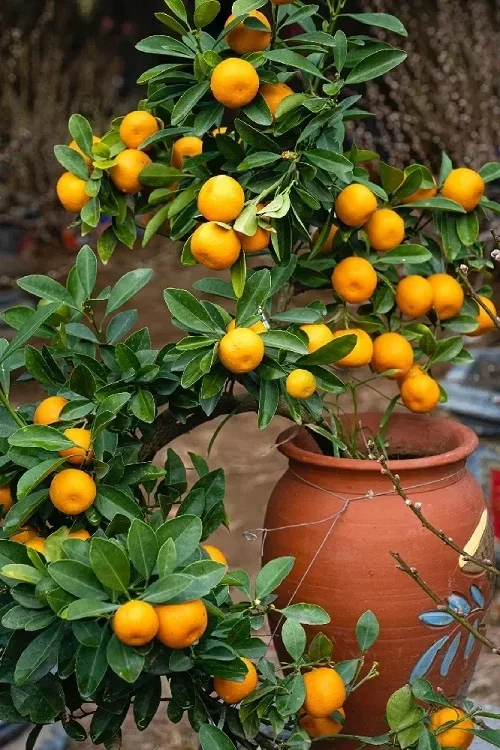
A large pot gives the tree plenty of room for its roots to spread out and grow. The drainage holes are necessary to ensure that the soil does not become waterlogged and cause the tree’s roots to rot.
The minimum container size would depend on the variety of orange trees you plant to grow. Generally, citrus trees should be grown in containers that are at least 16-18 inches in diameter and 18-20 inches in depth. For starters, you can start the plant in a standard 10-12 inches pot and then re-pot it into a bigger one as it grows and spreads.
Requirements for Growing Oranges in Pots
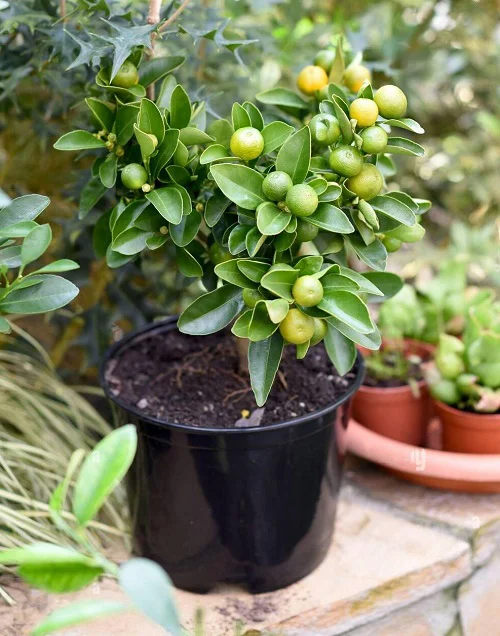
Location
The best location for growing an orange tree is with full sun, well-drained soil, and protection from strong winds. It prefers warm climates, so it should also be in an area that does not experience extremely cold temperatures. A spot that is sheltered from strong winds will also help to protect the tree from damage.
These plants need at least 8-10 hours of direct sunlight daily. When growing it in pots, it is important to place them in a location that receives full sun.
If you cannot provide that much direct sunlight, supplement it with artificial lighting. Make sure to move the pot around periodically to ensure even sunlight exposure.
Soil
The best soil for growing an orange tree is well-draining, nutrient-rich soil that is high in organic matter. The soil should be slightly acidic and slightly moist.
The pH should be between 6.0 and 6.5. Adding compost or aged manure to the soil can help improve the drainage and nutrient content of the soil. Additionally, it is important to ensure the soil has adequate drainage to avoid root rot and other diseases. manure.
Water
Right watering is essential to ensure it grows healthy and strong. The tree should be watered deeply and regularly, about once a week.
It’s best to water in the morning, so the tree has time to absorb the water during the day. Water near the base of the tree and avoid wetting the leaves, as this can lead to disease. In hot or dry climates, you may need to water twice a week.
Temperature
The best temperature to grow this plant is between 65-85°F (18-29°C). Orange trees prefer warm, sunny climates with temperatures that don’t dip too low in the winter.
Orange Tree Care in Containers
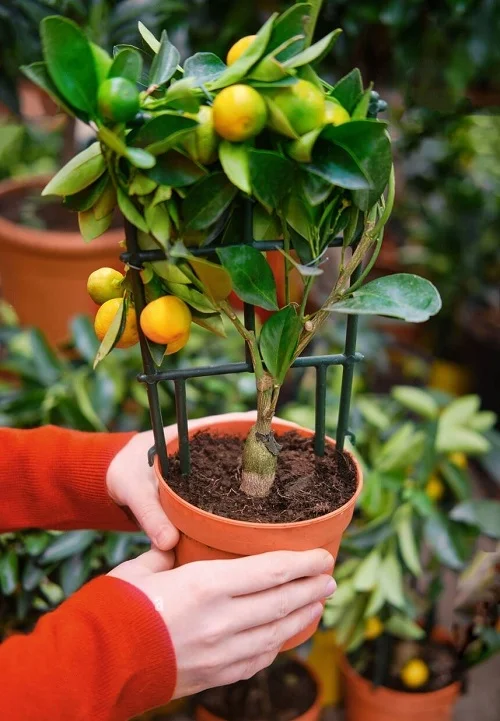
Fertilizer
Fertilizing timely is important for growing healthy, abundant fruit. The best time to fertilize an orange tree is in the spring and summer months when the tree is actively growing.
Use a balanced fertilizer, such as a 10-10-10 or 8-8-8 formula, and apply it around the base of the tree according to the instructions on the package. Fertilize your plant every six to eight weeks, and water it thoroughly after application.
Make sure the fertilizer does not come into contact with the trunk of the tree, as this can cause burning. If you are unsure of how much fertilizer to use, consult a professional.
Pruning
In the United States, the best time to prune your orange tree is in late winter or early spring, when the tree is dormant. This is usually between late February and early April.
Pruning is an important part of maintaining a healthy tree and is necessary for optimal yield. You can do this twice a year, once in the late winter or early spring and once in the late summer or early fall.
When pruning, aim to remove any dead, diseased, damaged, or crossing branches. This can help to reduce disease, improve airflow, and create a more open structure for the tree.
When pruning, use clean, sharp pruning shears and make sure to cut the branch at a 45-degree angle, which will help it heal quickly. Be sure to also remove any suckers or water sprouts that may be growing from the trunk or roots.
Finally, prune the tree to create a balanced structure and to ensure that the center of the tree is open. This will help to promote airflow, which can help to reduce disease and improve yields.
Re-Potting
1. Gather your materials: potting soil, a new pot, a potting mix containing fertilizer, a trowel, and a pair of garden scissors.
2. Carefully remove the tree from its current pot.
3. Gently loosen the roots and remove any extra soil.
4. Place the tree in the new pot at the same depth as it was in its old pot.
5. Add some of the potting mix, so that it covers the roots and fills the pot.
6. Use the trowel to firm the soil around the roots.
7. Water the tree thoroughly to help the soil settle.
8. Add more potting mix if needed.
9. Place the tree in an area with bright, indirect light, and water it regularly.
10. Prune the tree, if needed, using the garden scissors.
Orange Tree Care in Winter
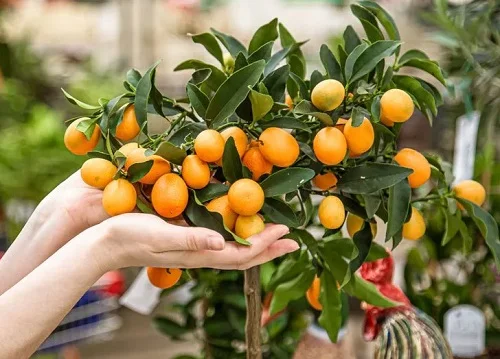
1. Move Indoors: If your orange tree is in a container and cannot be moved, move the container indoors to a bright, sunny spot.
2. Water Sparingly: During the winter months, water only when the top 1-2 inches of soil feels dry.
3. Avoid Temperature Extremes: Keep the temperature environment consistent. Keep it away from direct drafts and avoid temperatures below 40°F.
4. Adjust Fertilizer: Reduce the amount of fertilizer during the winter, as you are not expecting it to flower or fruit.
5. Prune: Prune in late winter by removing any dead or diseased branches.
6. Monitor for Pests: Monitor the plant for any signs of pests, such as aphids or whiteflies, and treat the tree accordingly.
Pests and Diseases
Pests:
1. Citrus Canker: A bacterial disease that causes sunken, dark lesions on leaves, twigs, and fruit.
2. Citrus Greening Disease: This bacterial disease causes yellow mottling and blotches on the leaves and fruit.
3. Citrus Leafminer: A small fly that lays its eggs in the citrus leaves and when hatched, the larvae tunnel into the leaves, causing them to become distorted.
4. Citrus Rust Mite: A tiny mite that feeds on the leaves of citrus trees, causing yellow or brown spots.
5. Scales: Scales are tiny insects that suck the sap from the leaves and twigs of citrus trees.
6. Citrus Thrips: These small pests feed on the leaves and fruit of citrus trees, causing them to become distorted.
7. Spider Mites: These mites suck the sap from the leaves and twigs of citrus trees, causing yellow spots and distorted growth.
Diseases:
1. Phytophthora Root Rot: Phytophthora root rot is a fungal disease that can cause significant damage. Symptoms of this disease include wilting of the leaves, loss of vigor, discoloration of the foliage, and root decay.
2. Citrus Canker: Citrus canker is a bacterial disease that affects the leaves, twigs, and fruits of orange trees. Symptoms include small, yellowish lesions on the leaves and twigs, as well as sunken, brown spots on the fruit.
3. Citrus Greening: Citrus greening is a bacterial disease that affects the leaves, twigs, and fruits. Symptoms include yellowing of the foliage, stunting
Harvesting Oranges
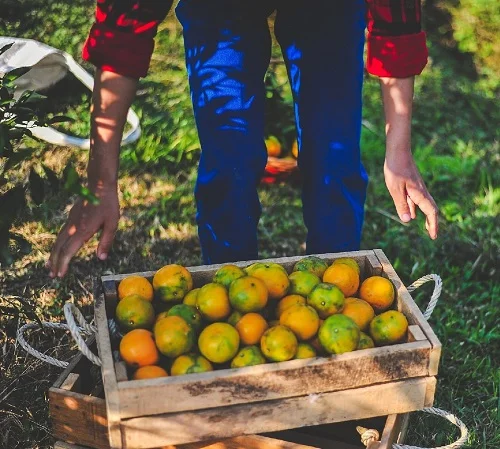
Harvesting oranges is a relatively easy process that can be done with minimal tools and effort.
1. Look for orange fruits that are firm and heavy for their size and have a bright orange color.
2. Put on protective clothing. Wear long sleeves and pants to protect your skin from sharp branches and thorns.
3. Gently shake the branches of the tree to dislodge ripe oranges.
4. Place a large tarp or sheet beneath the tree to collect the oranges.
5. Carefully pick the oranges off the branches or cut them off with pruning shears.
6. Place the oranges in a bucket or basket.
7. Wash the oranges with a mild detergent and water before eating.
